Bhakti Movement Saints: From Adi Shankara to Kabir, Divine Devotion & Social Reform
![]() May 15, 2024
May 15, 2024
![]() 117
117
![]() 0
0
Introduction
The Bhakti Movement in India witnessed the rise of several luminaries who revolutionized religious discourse and societal norms. From the philosophical depth of Adi Shankaracharya’s Advaita Vedanta to the egalitarian vision of Kabir’s syncretic poetry, each figure left an indelible mark on the spiritual landscape.
Bhakti Movement Saints: Divine Devotion Across Ages and Regions
Adi Shankaracharya (788-820 AD)
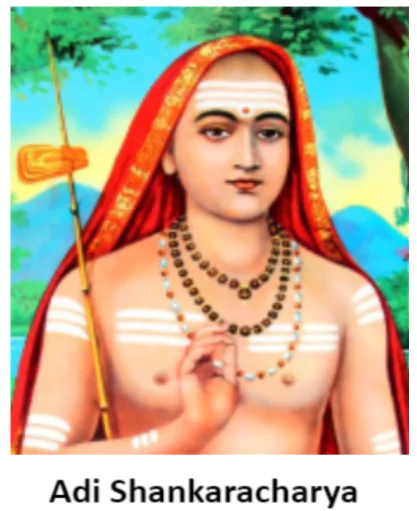
- Birthplace: He was born in Kaladi, kerala.
- Pioneer of Philosophical Bhakti Discourse: Adi Sankara’s arrival marked the beginning of philosophical Bhakti discourse in Sanskrit.
- Propounding Advaita Vedanta: He propounded the theory of Advaita Vedanta(Non-Dualism). Sankara’s Advaita, or non-dualism, had its roots in Vedanta or Upanishadic philosophy.
- Monasteries and Preserving Scriptures: The two main thrusts of the Sankara school were the organisation of monasteries and the preservation of Sanskrit scriptures.
- His attempts to root out Buddhism and to establish smarta (traditionalist) mathas resulted in the establishment of monasteries in different places viz., Sringeri, Dvaraka, Badrinath, and Puri, which were headed by Brahmin pontiffs.
- Harmony of Saiva and Vaishnava Worship: Sankara looked upon Saiva and Vaishnava worship as two equally important aspects of the Vedic religion.
- Honoring a Sage: A 12-foot statue of Shankaracharya was established in Kedarnath.
Ramanuja (1017-1137 AD)
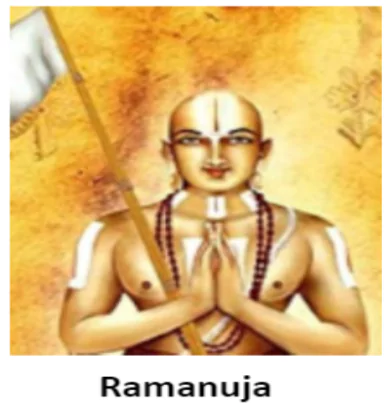
- A southern reformer who made a pilgrimage to some of the holy places in Northern India.
- Advocate of Vishistadvaita: He challenged the monist ideology of Adi Sankara and propounded Vishistadvaita (Qualified Monoism).
- Beyond Social Boundaries: Ramanuja took an interest in propagating the doctrine of Bhakti to social groups outside the varnashrama system.
- He influenced temple authorities to permit them to enter the temple at least once a year.
- He firmly believed that intense devotion to Vishnu was the best means to attain salvation.[UPSC 2022]
- Teaching in the Vernacular: His teachings were based on the Upanishads and Bhagwad Gita and taught in a common language.
- Influence of Srirangam School: He was influenced by the teachings of the Srirangam school of thought.
- Ramanujar joined it and was later declared the head of a monastery in Srirangam.
- Legacy of Leadership: His disciple, Ramanand, later propagated his message in Northern India.
- Schism and Successors: A century after his death, there was a schism which developed into two separate schools under Vedanta Desikar and Manavala Mamuni.
- Statue of Equality: Recently, the Statue of Equality was constructed in Hyderabad to commemorate the 1000-year anniversary of Ramanujacharya.
Namdeva (1270-1350 AD)
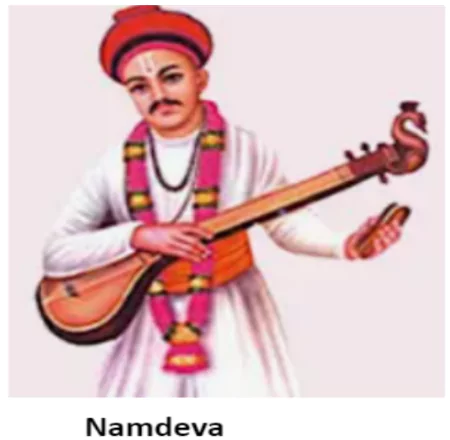
- From Tailor to Bhakti Movement Saints: He came from a family of tailors. He popularised the Bhakti Movement in Maharashtra and was closely associated with the Varkari Sect.
- Spiritual Transformation: He was converted to the path of bhakti under the influence of Saint Janadeva.
- Abhangs: He wrote many abhangs (songs composed and sung in the glory of God) in Marathi and Hindi, and later, some of his verses were added to Guru Granth Sahib.
- Essence of Namdeva’s Message: Love god with all your heart to lead a pious life, surrendering everything to him with steadfast devotion is the essence of his message.
Varkari sect
|
Jnaneshwar (1275-1296 AD)
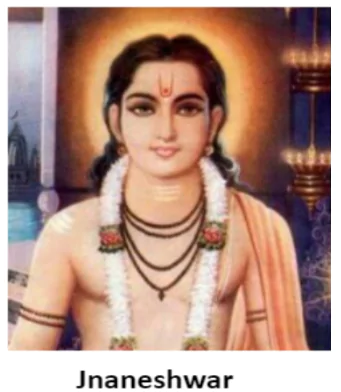
- Vithoba Devotee: Saint of Maharashtra, revered Vishnu as Vithoba or Krishna.
- Jnaneshwari: He translated the Bhagavad Gita from Sanskrit to Marathi, called Jnaneshwari.
- Contemporary of Philosophical Giants: He was contemporary to Shankara and Ramanuja.
- Varkari Tradition: He is considered one of the most influential figures in the Varkari religious tradition.
- Ashtadasha Shiva Hikari: His poetic work on Shiva named the Ashtadasha Shiva Hikari is a poetic compilation of 18,000 verses.
Ramananda (1400-1470 AD)
- Preacher of Hindi Vaishnavism: He was a follower of Ramanuja and preached Vaishnavism in Hindi. He was the first to preach his doctrine of devotion in Hindi, the vernacular language.
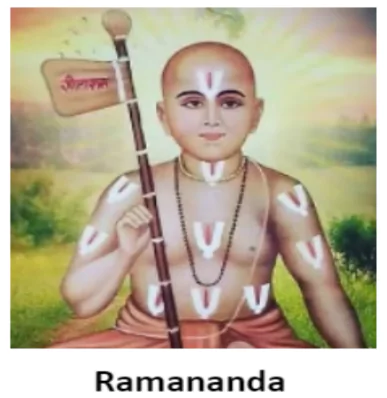 Radical Reformer: A devoted worshipper of Rama, educated in Benaras. By establishing his own sect based on the philosophy of love and devotion to Rama and Sita, Ramananda introduced radical changes in Vaishnavism.
Radical Reformer: A devoted worshipper of Rama, educated in Benaras. By establishing his own sect based on the philosophy of love and devotion to Rama and Sita, Ramananda introduced radical changes in Vaishnavism. -
- He substituted the worship of Rama in place of Vishnu.
- Equality and Inclusivity: He advocated equality before God and rejected the caste system, particularly the supremacy of Brahmins.
- He welcomed followers from all castes and backgrounds and had twelve chief disciples, which included Saint Kabir, Ravidas and a woman named Padmavathi.
- Embracing Unity: He famously used to say “Let no man ask a man’s sect or caste”.
Kabir (1398-1448 AD)
- Weaver Saint of Varanasi and Vedanta Scholar: He was probably a weaver, born in Varanasi.
- Learned Vedanta philosophy from Swami Ramananda.
- Interfaith Influences: According to Tazkirah-i-Auliya-i-Hind (Lives of Muslim Saints), he was a disciple of the Muslim Sufi, Shaikh Taqi.[UPSC 2019]
- Syncretic Poetry: His poems express a wide range of ideas, blending Sufi and Hindu ideas like ‘zikr’ and ‘Nam-simaran’ and taught that Allah and Eswar, Ram, and Rahim are one and the same.
- Iconoclasm and Social Critique: He had no faith in idol worship polytheism and denounced the caste system.
- He equally condemned Muslim formalism.
- Preservation of Kabir’s Legacy: Kabir’s verses exist in three distinct traditions:
- Kabir’s Bijak is preserved by the Kabirpanth (the path or sect of Kabir). [UPSC 2014]
- Kabir Granthavali by Dadupanth in Rajasthan.
- Adi Granth Sahib: His poems often invert everyday meanings (“Ulatbansi” or upside-down sayings) to hint at the complexity of expressing the Ultimate Reality.
| Must Read | |
| Current Affairs | Editorial Analysis |
| Upsc Notes | Upsc Blogs |
| NCERT Notes | Free Main Answer Writing |
Conclusion
The Bhakti movement, marked by its inclusive ethos and devotion to the divine, brought forth a tapestry of spiritual luminaries who transcended societal divisions. From Adi Shankaracharya’s philosophical underpinnings to Kabir’s iconoclasm, each figure enriched the spiritual landscape with their unique contributions. Their enduring legacy, manifested in songs and verses, resonates across generations, offering solace and inspiration in the pursuit of divine love and unity.
| Related Articles | |
| BHAKTI MOVEMENT: IMPORTANCE, NAYANARS | Veerashaiva Mahasabha |
| Economic Development: Challenges and Goals Explored | Sangam Age – Political History Of South India |
Recommended For You
Integration of PYQ within the booklet
Designed as per recent trends of Prelims questions
हिंदी में भी उपलब्ध
UDAAN PRELIMS WALLAH
Integration of PYQ within the booklet
Designed as per recent trends of Prelims questions
हिंदी में भी उपलब्ध
<div class="new-fform">
</div>










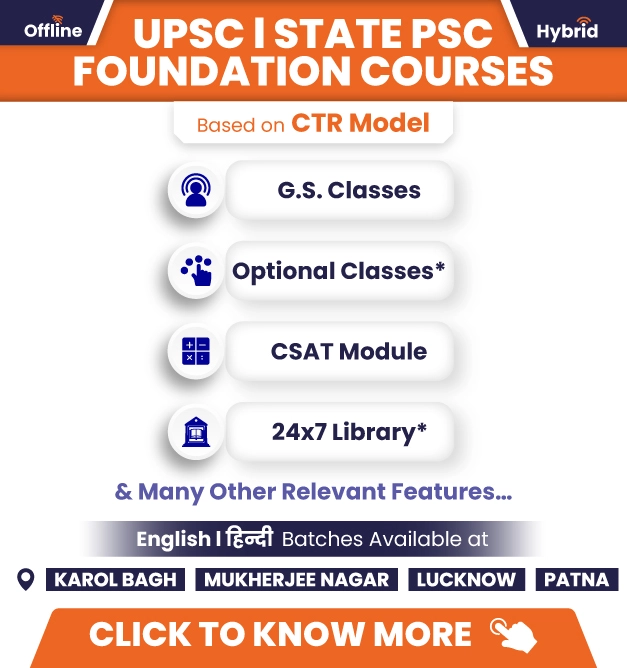





Latest Comments